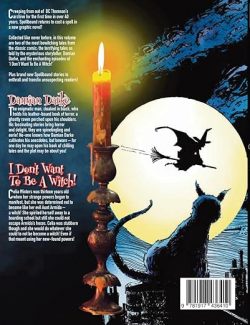
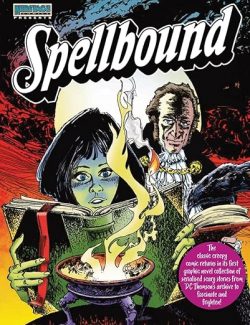
By Daniel McGachey & Lauren Knight, Georgia Standen Battle, Brian Lewis,
Du Feu & Francisco Cueto, Alan Hebden & Patrick Wright, Kek W. & Jaume Forns, &Vicente Alcazar, & various (Heritage Comics/DC Thomson & Co.)
ISBN: 978-1-91743641-0 (TPB/Digital edition)
This book includes Discriminatory Content produced in less enlightened times.
DC Thomson is probably the most influential comics publisher in British history. In the 1930s The Dandy and The Beano revolutionised children’s comedy comics, whilst newspaper strips Oor Wullie and The Broons (both created by writer/Editor R. D. Low and Dudley D. Watkins) have become a genetic marker for Scottishness. The company uniquely portrayed the occasional toff, decent British blokes and working-class heroes who grew from the prose-packed pages of Adventure, Rover, Wizard, Skipper, Hotspur and latterly “strip picture papers” like Victor and Warlord. They also cannily followed wider-world trends and capitalised – as much as any tasteful, all-ages publishing house could – on global interests that filtered down to juvenile consumers.
Their Girls Papers line especially shaped successive generations and, whenever cited, examples still evoke passionate memories. Don’t take my word for it either; just ask your mum or grandmother about Judy, Bunty, Diana, Mandy and the rest…
And that goes double for the spooky sagas in Spellbound…
Kids have always delighted in scary stories but the 1970s horror bubble presented lots of problems for comics publishers. With parents and watch groups always readily on hand to complain or kick up a fuss, how to cater to a genuine demand without incurring another 1950s style comics panic was uppermost in every comic editor’s mind. The answer, obviously is with style, imagination and caution…
Predating Fleetway’s fantasy icon Misty by a couple of years, Spellbound – “the all-new mystery story paper for girls”- launched from DC Thompson’s haunted mansion on September 25th 1976.
Opening in plenty of time for Halloween, it ran for 69 issues before merging in January 1978 with generally-school-&-fashion-themed title Debbie. In its time Spellbound recounted horror-tinged fantasy tales along traditional lines, mixed with school scenarios and, as always, supplemented by text features, activities, and general interest snippets. Its true rewards and achievements rested in the roster of stellar creators associated with its solo strips and serials: artisans including Brian Lewis, Estaban Maroto, Edmond Ripoll, Enrique Badía Romero, Jésus Redondo, Adolfo Usero, Jordi Franch, Norman Lee and others for material including ‘When the Mummy Walks’, ‘The Secret of Silver Star’, ‘Supercats’, ‘The Haunting of Laura Lee’, ‘Peril on Paradise Island’ and more.
DCT is constantly looking for better ways to reach fresh audiences and recently moved into digital publishing of vintage and original new stories in a big way. Backing up their Commando war stories and Starblazer science fiction reprint projects comes this initially digital-only treat: a timely compilation of supernatural sagas is an ideal way to expand their Heritage Comics imprint (expect more reviews in coming months).
This blockbuster tome collects many magnificently understated macabre moments from the periodical, focussing at first on short stories narrated by Master of Mystery Damian Darke before closing with a complete serial from Spellbound #1-15. Throughout, the monochrome lore is littered with those aforementioned prose featurettes and the occasional full colour cover reproduction, and the entire fear fest is festooned with new stuff such as informative
opening letter to the readers ‘Spellbinding Tales…’
Then comes a new introductory spooky strip by Daniel McGachey & Lauren Knight, as wayward teens Gwen & MacKenzie – who really should know better – break into an old abandoned house and discover the world is not what they thought it was…
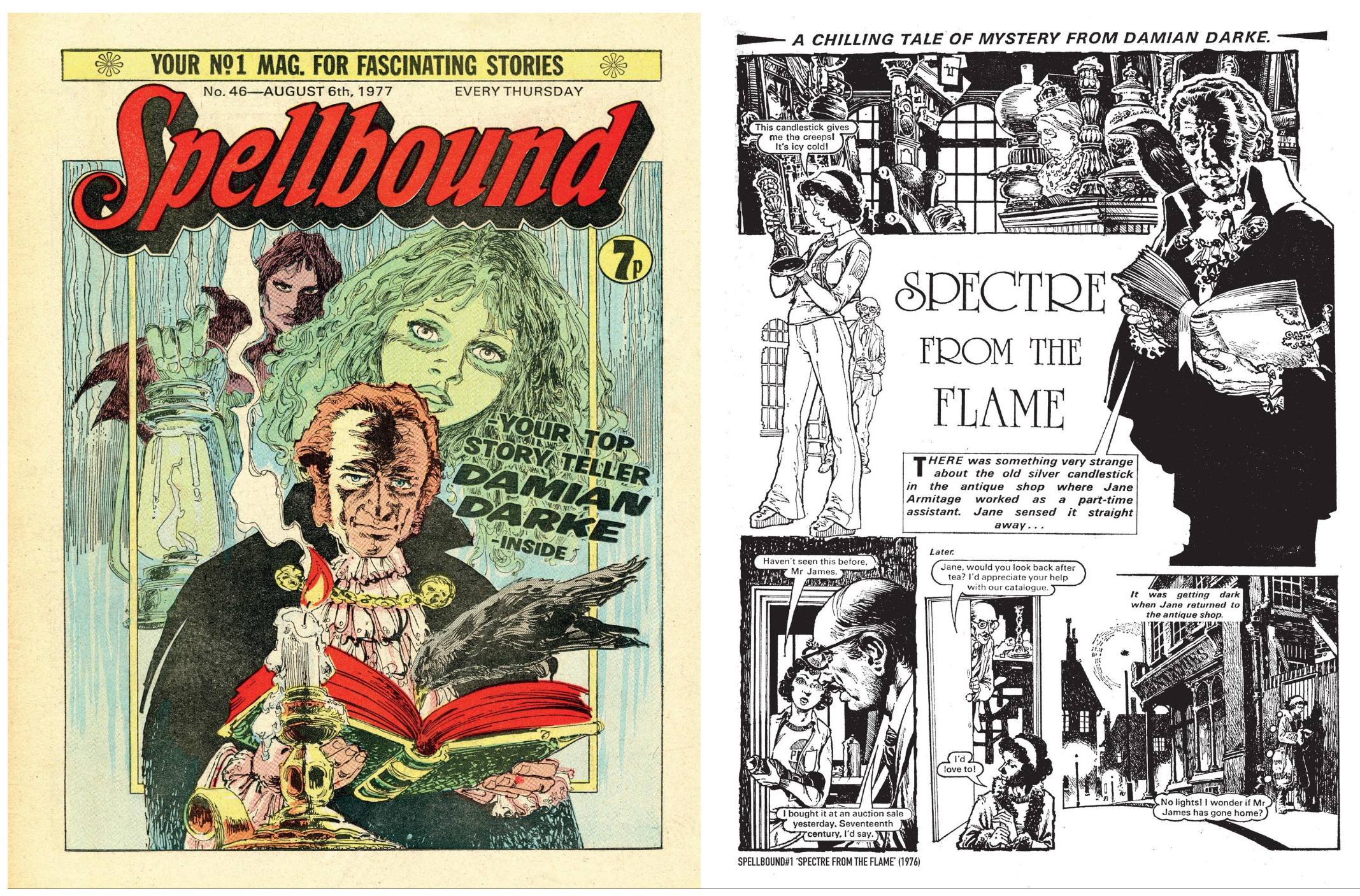
The cover of #46 (August 6th 1977) leads to our introduction to the Man of Mystery from Spellbound #1, as Damian Darke describes the events of a judicial ‘Spectre from the Flame’ returning to punish evildoers from beyond the grave in a superb chiller limned by Brian Lewis. Next, Jenny & Denise experience a ‘Journey into Fear’ (#19) when they are lost in a storm on the Yorkshire Dales and fetch up at an old edifice that is absolutely not the youth hostel they’re looking for…
That’s augmented with prose potted ghost story ‘Spellbound Special Feature: Poor Little Rich Boy’ from #4, before Lewis strikes again with ‘The Warning’ (#46) wherein hikers Joan & Babs meet a little girl who literally isn’t there (anymore…) whilst from Spellbound #2, “biker chick” Lindsay Gordon inadvertently survives a very close encounter with Cumbrian legend the ‘Ghost Rider’ before ‘Spellbound Special Feature: Get Friendly with Your Phantom’ (#12) textually tells of how to act if one gets too close to the dead-&-not-gone…
Haunted objects ‘The Preston Figurines’ (#36) move heaven and earth to be reunited when sold separately at an antique shop, after which – from #7 – Darke details how a mean miserly usurer gets his just deserts in the ‘Swamp of Evil’: a period piece neatly bookended by text tract ‘Spinning Spectres’ from #13.
Spectral salvation and revelatory redemption come when lost voyager Judy Rose survives a snowstorm thanks to ‘The Cavalier’s Cloak’ (#37) even as in #35 horse lover Kathy King is saved from certain swampy death by ‘The Ghost of Whitefire’ – a modern myth bolstered by prose historical pointers in #17’s ‘Spellbound Special Feature: Milady Greensleeves’…
From Spellbound #21, ‘Mystery at Howlen Hall’ revisits classic gothic literature as a sister searches for a lost sibling at a creaky old manse and only finds madness and worse, whilst Lewis shines in a sentimental scare-fest involving a valiant dead puppy and an ‘Echo on the Wind’ (#4) prior to prose ‘Special Feature: Mr Nobody’ taking a peep at people who aren’t there…
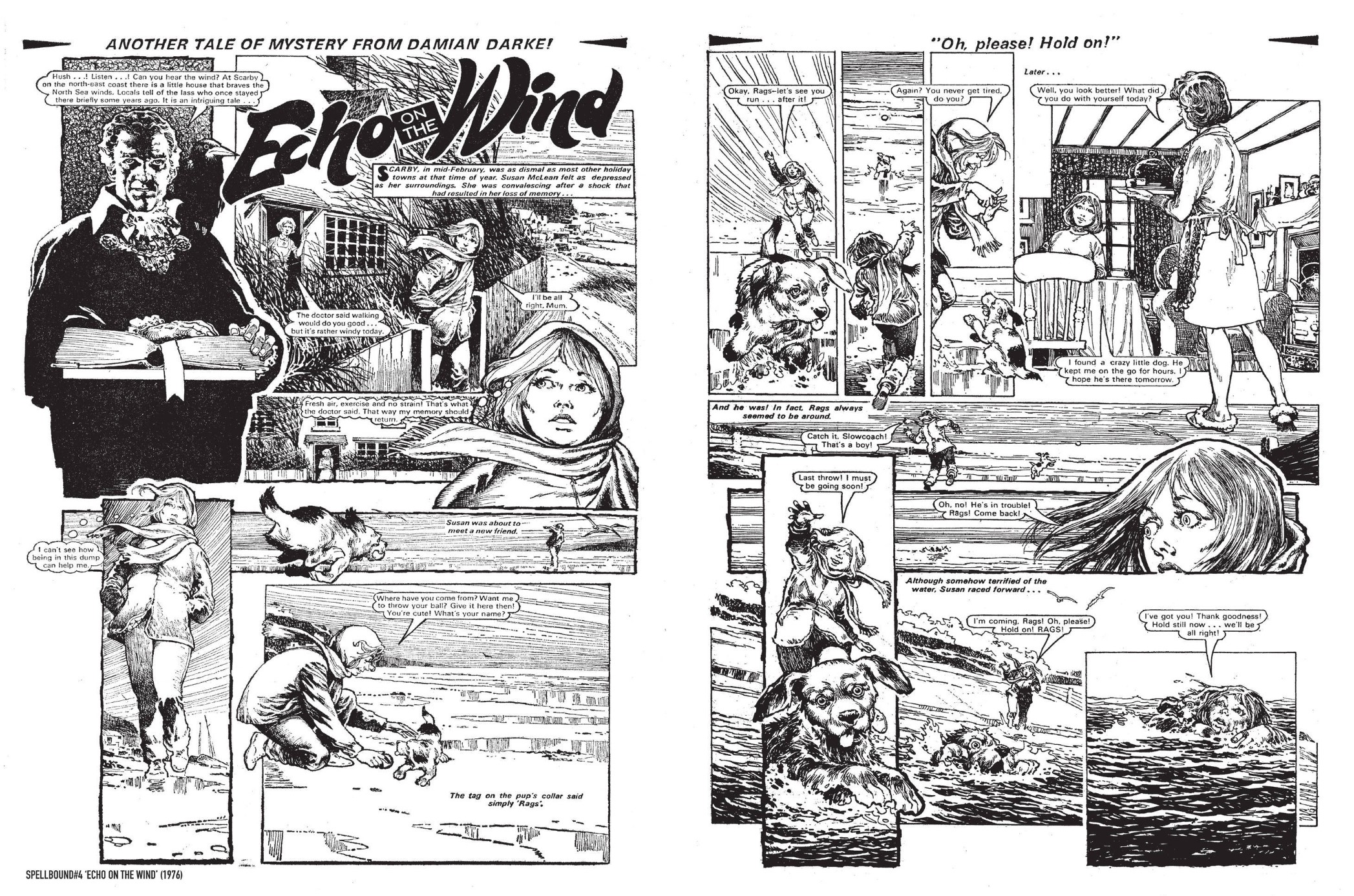
Murder from beyond and a most unquiet landlady garnish a florid tale of perilous ‘Poison Ivy’ (#48), whilst Victorian vignette ‘The House of Palgrave’ (#3 by Lewis) explores a Cornish dwelling that is in no way welcoming to its owner’s new bride, all before auction-going flatmates Sue & Carol get more than they bargained for after buying ‘A Spoonful of Evil…’ (#43). This brings Darke’s delightful diatribes to a halt for the present, allowing a ‘Spellbound Special Feature: The Housemaid’s Revenge’ (#28) and the cover to #8 (November 13th 1976) to usher in a classic serial…
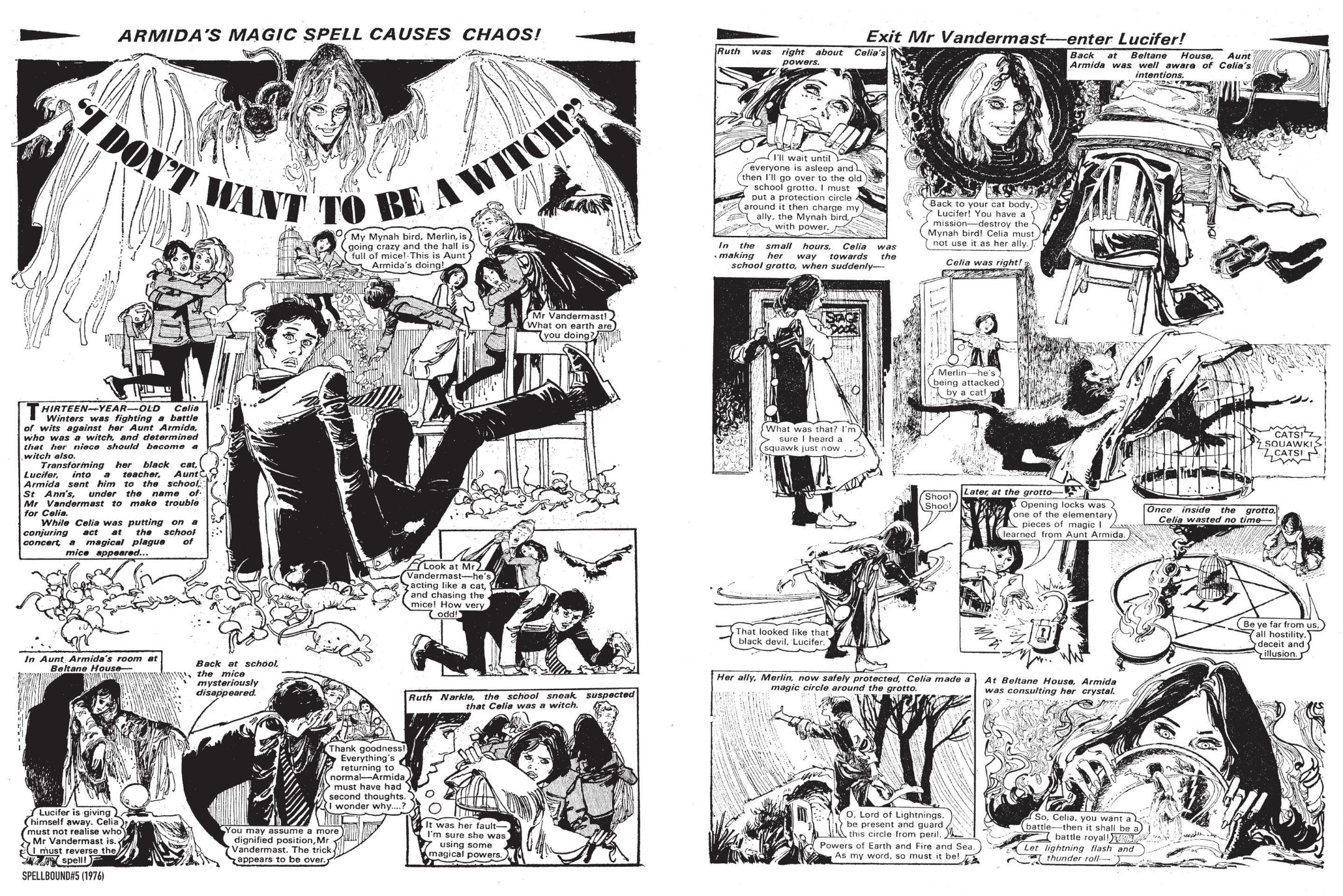
Illustrated by Norman Lee (When the Mummy Walks, The Shop at Shudder Corner, most Spellbound covers) ‘I Don’t Want to Be a Witch!’ is reprinted from Spellbound #1-15, and blends traditional outsider-at-boarding-school comedy drama with a hefty dose of wyrd warfare. However, here, 13-year-old Celia Winters perpetually foils the many schemes of her high witch aunt Armida who strives to make the teenager her vassal and mystic acolyte, but first must get her out of the infernal normal school she loves and away from all her friends at St. Ann’s…
For three action- and imagination-packed months, Celia, best pal Anne and pet Myna bird Merlin duck & dodge & dive, craftily utilising the hidden magic grotto on school grounds (“normal life” huh?) to foil Auntie’s every incredible ploy. Constant chaos and bewildered teachers cannot quell the madness, nor will her feline familiar Lucifer and spiteful tattle-tale mean girl Ruth Narkle hold back as they seek to squash Celia’s every effort to stay nice and normal. Eventually the escalating arcane pot boiler inevitably bubbles over…
‘I Don’t Want to Be a Witch!’ may have ended but is here revived in a creepy continuance by Georgia Standen Battle & Anna Morozova who introduce a fresh new generation to close this tome…
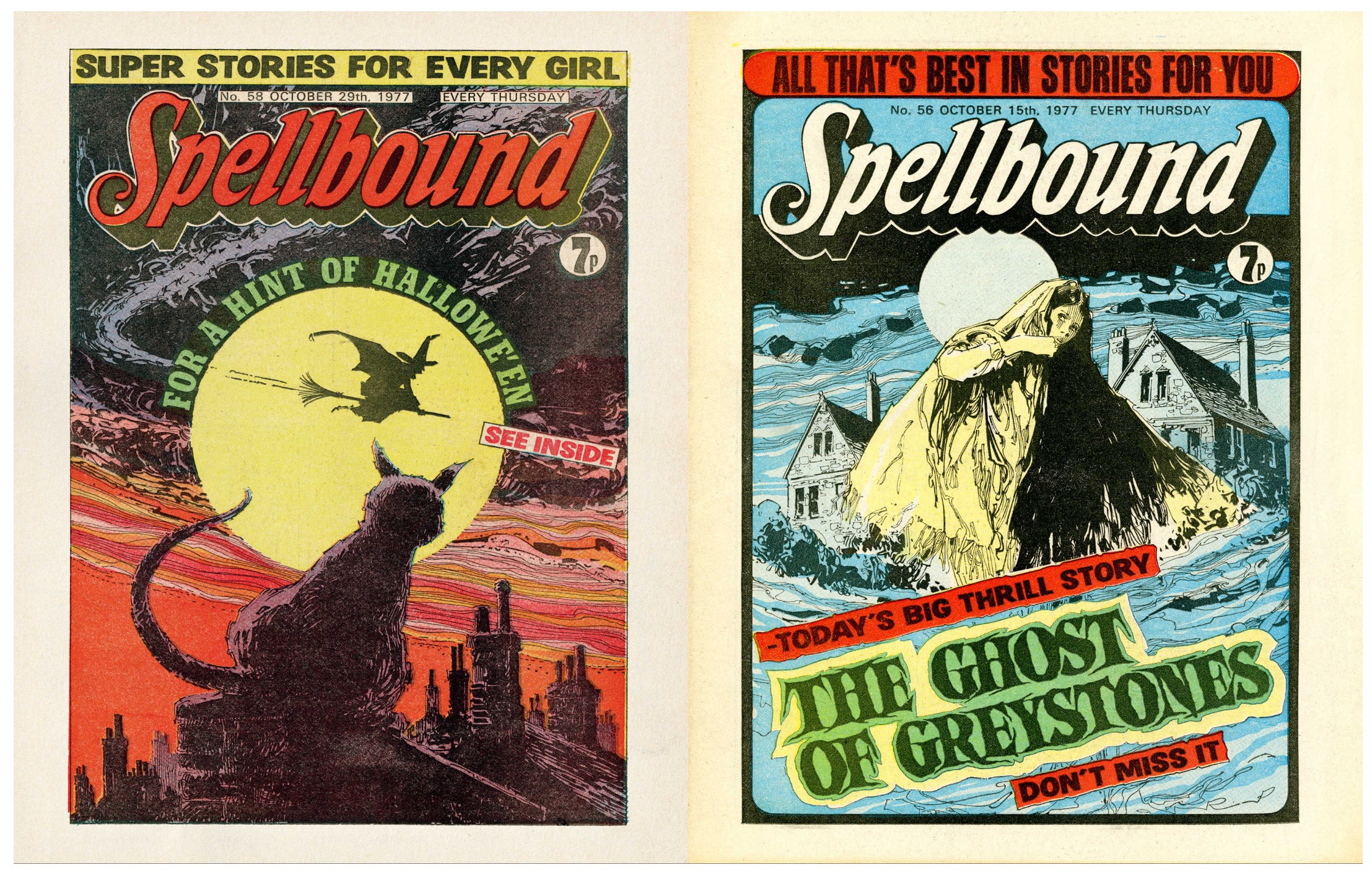
Rounding out the nostalgia chills is a final cover gallery – seven more scary front pages – accompanied by one last yarn: another illustrated prose poser from the first issue suitably entitled ‘Nightmare’…
Short sharp stories of solidly spooky standing superbly rendered make this a horror fan’s delight and a welcome doorway into more inviting times. Why not climb aboard this coachload of chillers and see what used to make our spines shudder and shake?
© DC Thomson & Co., Ltd. 2019.
Today in 1922 Maurice Dodd was born. We love him for one of the world’s greatest comedy strips. So will you if you scope out The Perishers Spectacolour.

Be very wary of buying the print edition of this title on Amazon. My copy was such poor quality I’m returning it for a refund.
It seems to be “print on demand”, and gives the appearance of being done as cheaply as possible by a chancer who’s bought the download.
The cover is thinner than you’d expect of a paperback, has a peculiar rubbery texture, and has a distracting white edge all around. Less than an hour after receiving it and being placed on a table, the cover started curling up.
The paper is very thin, and the ink is very light in places, making it difficult to read many pages. I viewed the sample of the Kindle edition, and not only was the ink considerably darker, but it turned out colour pages had been printed in black-and-white!
Worst of all, the first quarter of the book comprised of another, wholly inappropriate book (The Artificial Insemination Of Bees).
I posted a review pointing out all these deficiencies, and drew Amazon’s attention to the misleading description.
DO NOT BUY THE PRINT EDITION OF THIS BOOK! You might just as well buy the download, and print it yourself on quality paper (in colour where appropriate), and minus the superfluous pages.